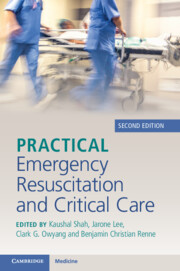Book contents
- Practical Emergency Resuscitation and Critical Care
- Practical Emergency Resuscitation and Critical Care
- Copyright page
- Contents
- Contributors
- Preface
- Section 1 General Critical Care
- Section 2 Infectious Disease Emergencies
- Section 3 Neurological Emergencies
- Section 4 Cardiovascular Emergencies
- Section 5 Respiratory Emergencies
- Section 6 Gastrointestinal Emergencies
- Section 7 Renal Emergencies
- Section 8 Hematology–Oncology Emergencies
- Section 9 Endocrine Emergencies
- Section 10 Environmental Emergencies
- Section 11 Trauma
- 47 General Trauma Principles
- 48 Severe Traumatic Brain Injury
- 49 Neck Trauma
- 50 Thoracic Trauma
- 51 Solid Organ Abdominal Trauma
- 52 Severe Pelvic Trauma
- 53 Soft Tissue Injury
- 54 Burn Resuscitation
- Section 12 End of Life
- Index
52 - Severe Pelvic Trauma
from Section 11 - Trauma
Published online by Cambridge University Press: 02 November 2023
- Practical Emergency Resuscitation and Critical Care
- Practical Emergency Resuscitation and Critical Care
- Copyright page
- Contents
- Contributors
- Preface
- Section 1 General Critical Care
- Section 2 Infectious Disease Emergencies
- Section 3 Neurological Emergencies
- Section 4 Cardiovascular Emergencies
- Section 5 Respiratory Emergencies
- Section 6 Gastrointestinal Emergencies
- Section 7 Renal Emergencies
- Section 8 Hematology–Oncology Emergencies
- Section 9 Endocrine Emergencies
- Section 10 Environmental Emergencies
- Section 11 Trauma
- 47 General Trauma Principles
- 48 Severe Traumatic Brain Injury
- 49 Neck Trauma
- 50 Thoracic Trauma
- 51 Solid Organ Abdominal Trauma
- 52 Severe Pelvic Trauma
- 53 Soft Tissue Injury
- 54 Burn Resuscitation
- Section 12 End of Life
- Index
Summary
Severe pelvic fractures are a major cause of morbidity and mortality in trauma patients. As hemorrhage is the main cause of mortality in pelvic trauma, it is critical to assess hemodynamic stability and identify ongoing bleeding in the chest, abdomen and long bones. If no clear source of hemorrhage is identified and a patient remains unstable, suspicion for primary pelvic hemorrhage should be high. Suspect pelvic fracture in all cases of serious or multisystem trauma patients.
In pelvic trauma, there is a high incidence of associated injuries; therefore, special attention should be paid to the rectal and urogenital examinations. The most commonly used classification system for pelvic fractures is the Young–Burgess system. This system categorizes injuries on the basis of mechanism of injury and can be used to predict the risk of blood loss.
Keywords
- Type
- Chapter
- Information
- Practical Emergency Resuscitation and Critical Care , pp. 561 - 566Publisher: Cambridge University PressPrint publication year: 2023

